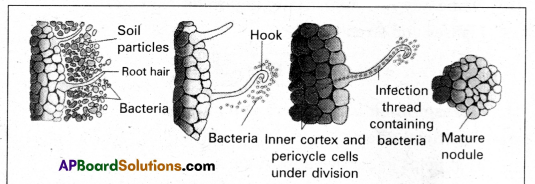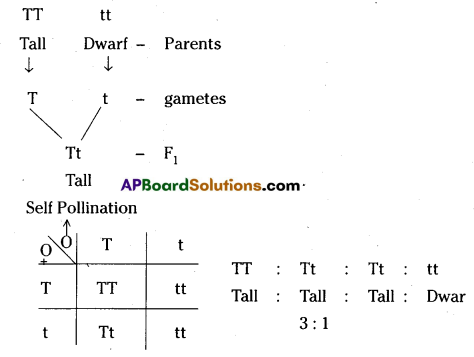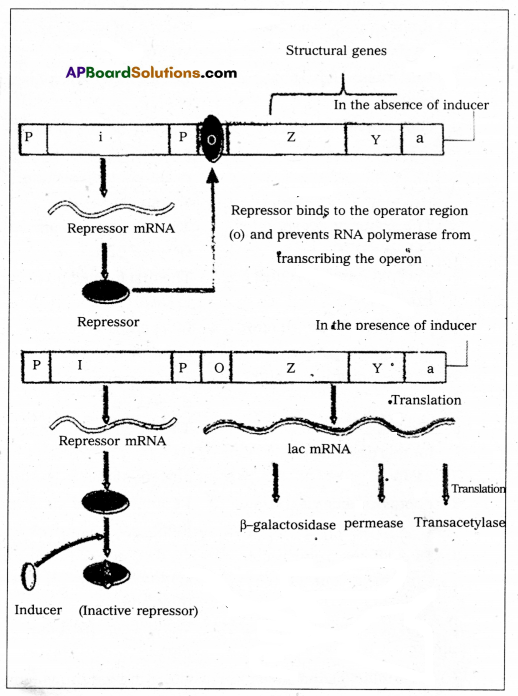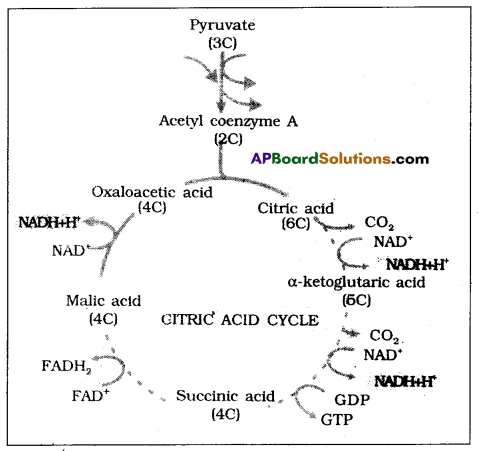Thoroughly analyzing AP Inter 2nd Year Botany Model Papers and AP Inter 2nd Year Botany Question Paper May 2019 helps students identify their strengths and weaknesses.
AP Inter 2nd Year Botany Question Paper May 2019
Time : 3 Hours
Max. Marks: 60
Note: Read the following instructions carefully:
- Answer all the questions of Section – A. Answer any six questions out of eight in Section – B and answer any two questions out of three in Section – C.
- In Section – A, questions from SI. Nos. 1 to 10 are of Very Short Answer Type”. Each question carries two marks. Every answer may be limited to 5 lines. Answer all the questions at one place in the same order.
- In Section – B, questions from SI.Nos. 11 to 18 are of “Short Answer Type’. Each question carries four marks. Every answer may be limited to 20 lines.
- In Section – C, questions from SI. Nos. 19 to 21 are of “Long Answer Type”. Each question carries eight marks. Every answer may be limited to 60 lines.
- Draw labelled diagrams, wherever necessary for questions in Sections B and C.
Section – A
10 × 2 = 20
Note: Answer all the questions. Each answer may be limited to 5 lines:
Question 1.
What are porins? What role do they play in diffusion?
Answer:
Porins are proteins that form huge pores in the outer membranes of the plastids, Mitochondria and some Bacteria, allowing molecules upto the size of small proteins to pass through.
Question 2.
What is the primary acceptor of CO2 in C3 plants? What is the first stable compound formed in a Calvin cycle?
Answer:
In C3 plants, the primary acceptor of CO2 is RUBP. The first stable compound formed in Calvin cycle is PGA.
Question 3.
What is conjugation? Who discovered it and in which organism?
Answer:
The transfer of DNA from one Bacterium to another Bacterium through direct contact is called conjugation. It was first observed in E.Coli by Lederberg and Tatum (1946).
Question 4.
Explain the terms phenotype and genotype.
Answer:
The physical or external appearance of a character is called phenotype. The genetic makeup of an individual is called Genotype.
![]()
Question 5.
What are the components of a nucleotide?
Answer:
A nucleotide consists of three components namely a nitrogenous base, a pentose sugar, and a phosphate group.
Question 6.
Write any two chemical differences between DNA and RNA.
Answer:
| DNA | RNA |
| 1) Deoxyribose sugar (C5H10O4) is present. | 1) Ribose sugar (C5H1005) is present. |
| 2) Nitrogen bases are A, T, G, and C. | 2) Nitrogen bases one A,U,G, and C. |
Question 7.
What is downstream processing?
Answer:
After completion of Biosynthetic stage, the product has to be subjected through a series of processes before it is ready to release into market as a finished product. The processes include separation and purification which are referred as downstream processing.
Question 8.
Name the nematode that infests the roots of tobacco plants. Name the strategy adopted to prevent the infestation.
Answer:
Meloidegyne incognitia a novel strategy adopted to prevent this infestation is process of RNA interference (RNAi).
Question 9.
What is meant by hidden hunger?
Answer:
It is a chronic lack of vitamins and minerals that often has no visible warning signs. It leads to mental impairment, poor health and productivity or even death.
Question 10.
What nucleopolyhedrovirus is being used for now-a-days?
Answer:
These viruses are excellent for species-specific, narrow-spectrum insecticidal applications (properties). They have been shown to have no negative impact on plants, mammals birds. fish or even on non-target insects.
Section – B
6 x 4 = 24
Note: Answer any six questions. Each answer may be limited to 20 lines:
Question 11.
How does ascent of sap occur in tall trees?
Answer:
Upward movement of water through xylem against gravitational force is called ascent of sap. The transpiration-driven ascent of xylem sap depends on –
- Cohesion – mutual attraction between water molecules.
- Adhesion – attraction of water molecules to polar surfaces.
- Transpiration pull – driving force for upward movement of water.
These properties give water high tensile strength and high capillarity. In plants, capillarity is aided by the small diameter of the tracheary elements. As water evaporates through the stomata, Since the thin film of water over the cells is continüous, it results in pulling of water, molecule by molecule into the leaf from the xylem.
Also, because of lower concentration of water vapour in the atmosphere, water diffuses into the surrounding air. This create transpiration pull. The forces generated by the transpiration can create pressure sufficient to lift xylem sized column of water over 130 meters high.
![]()
Question 12.
Explain the steps involved in the formation of root nodule.
Answer:
- Roots of legumes release sugars and amino acids which attached Rhizobium. They get attached to epidermal and root hair cells of the host.
- The roots hair curl and the bacteria invade the roots hair.
- An infection thread produced carrying the bacteria into the cortex of the root.
- Bacteria initiate nodule formation in the cortex of the root. Then the bacteria released from the thread into the cortical cells of the host and stimulate the host cells to divide. Thus leads to the differentiation of specialized nitrogen-fixing cells.
- The nodule thus formed establishes a direct vascular connection with the host for exchange of nutrients.

Development of root nodules in soyabean:
- Rhizobium bacteria contact a susceptible root hair, divide near it.
- Successful infection of the root hair causes it to curl.
- Infected thread carries the bacteria to the Inner cortex. The bacteria get modified into rod-shaped bacteroids and cause inner cortical and pericycle cells to divide. Division and growth of cortical and pericycle cells lead to nodule formation.
- A mature nodule is complete with vascular tissues continuous with those of the root.
Question 13.
Write briefly about enzyme inhibitors.
Answer:
Beneficial effects:
- It helps in passive absorption of water.
- It also helps in passive absorption of mineral salts by mass flow mechanism.
- It is the main force for ascent of sap.
- It regulates the temperature of plant body and provides cooling effect.
- Maintain shape and structure of the plants by keeping cell Turgid.
Harmful Effects:
- Excessive transpiration makes the cells flaccid which retards growth.
- Excessive transpiration leads to closure of stomata thus obstructing gaseous exchange.
Question 14.
Write note on agricultural/horticultural applications of auxins?
Answer:
- IAA, IBA and NAA help to initiate roots in stem cuttings. It is widely used in horticulture.
- 2, 4 – D, 2, 4, 5 – T acts as herbicides which kills abroad leaved dicot weeds.
- Auxins stimulate fruit growth in Tomato.
- Auxins induce flowering in pineapple.
- Auxins prevents preharvest fruit drop.
- Auxins favour the formation of female flowers in cucurbita.
Question 15.
Explain the structure of T – even bacteriophages.
Answer:
- The viruses which attack bacteria are called Bacteria phages. They were discovered by Twort (1915).
- Felix ‘d’Herelle (1917) coined the term Bacteriophage.
- Bacteriophages are tadpole-shaped with a large head and a tail.
- The head is hexagonal and is capped by hexagonal pyramid, measures about 65 x 95 nm.
- The head is formed with several cap-someres. each of which is a single protein.
- The head protein forms a semipermeable membrane enclosing the folded double-stranded DNA which is 1000 times longer than the phage.
- The tail is composed of several parts present around central core.

![]()
Question 16.
Explain the law of dominance using monohybrid cross.
Answer:
Characters are controlled by discrete units called factors. They occur in pairs. In a dissimilar pair of factors pertaining to a character, one number of the pair dominates the other. The law of dominance is used to explain the expression of only one of the parental characters in a monohybrid cross in the F1 and the expression of both in the F2 generations. It also explains the proportion of 3: 1 obtained at the F2 generation.

Question 17.
Draw the schematic/diagrammatic presentation of the Lacoperon.
Answer:

Question 18.
What are some biosafety issues concerned with genetically modified crops?
Answer:
- There is fear of transferring allergins or toxins to Humans and animals as side effect.
- There is a risk of changing the fundamental nature of vegetables.
- They may pose a harmful effect on biodiversity and have an adverse effect on environment.
- There is a risk of gene pollution due to transfer of new genes into related wild species through natural outcrossing. This may results in the development of super weeds which may be fast growing than the crops and may be resistant to weedicides.
- They may bring about changes in natural evolutionary patterns.
Section – C
2 x 8 = 16
Note: Answer any two questions. Each answer may be limited to 60 times:
Question 19.
Explain the reactions of Krebs cycle.
Answer:

The acetyl CoA eaters into the mitochondrial matrix a cyclic pathway tricarboxylic acid cycle, more commonly called krebs cycle after the scientist Hans Krebs who first elucidated it.
1. Condensation: In this acetyl CoA condenses with oxaloacetic acid and water to yield citric acid in the presence of citrate synthetase and CoA is released.
![]()
2. Dehydration: Citric acid looses water molecule to yield cis aconitic acid in the presence of aconitase.
![]()
3. Hydration: A water molecule is added to cisaconic acid to yield isocitric acid in the presence of a conitase.
![]()
4. Oxidation I: Isocitric acid undergoes oxidation in the presence of dehydrogenase to yield succinic acid.

5. Decarboxylation: Oxalosuccinic acid undergoes decarboxylation in the presence of decarboxylase to form α-keto glutaric acid.

6. Oxidation II, decarboxylation: α – keto glutaric acid undergoes oxidation and decarboxylation in the presence of dehydrogenase and condenses with co.A to form succinyl Co. A.

7. Cleavage: Succinyl Co.A splits into succinic acid and Co.A in the presence of thiokinase to form succinic acid. The energy released is utilised to from ATP from ADP and PI.

8. Oxidation – III: Succinic acid undergoes oxidation and forms 1’umaríc acid in the presence of succinic dehydrogenase.

9. Hydration: A water molecule is alcohol to Fumaric acid in the presence of Fumarase to form Malic acid.
![]()
10. Oxidation IV: Malic acid undergoes oxidation in the presence of malic dehydrogenase to form oxaloacetic acid.

In TCA cycle, for every 2 molecules of Acetyl Co.A undergoing oxidation, 2 ATF 8 NAÐPH+ H+, 2FADH2 molecules are formed.
![]()
Question 20.
Explain briefly the various processes of recombinant DNA technology.
Answer:
Key tools are:
1) Restriction enzymes: Two enzymes responsible for restricting the growth of Bacteriophage in Escherichia cou were isolated in the year 1963. One of these added methyl group to DNA and the other DNA. The latter was called restriction endonuclease. The first restriction endonuclease. Hind II which cut DNA molecule at a particular pair by recognising a specific sequence of six base pairs, called recognition sequence for Hind II. Today more than 900 restriction enzymes were isolated from over 200 strains of Bacteria each of which recognises a different recognition sequence.
E. CORI is a restriction enzyme in which, the first letter comes from the genus (escherichia) and the second two letters from the species of the prokaryotic cell (cou) the letter ‘R’ is derived from the name of strain. Roman numbers indicate the order in which the enzymes were isolated from the strain of Bacteria. Restriction enzyme belong to a larger class of enzymes called nucleases. They are of two types:
- Exonucleases which remove nucleotides from the ends of the DNA.
- Endonucleases which makes cuts at specific location within the DNA.
Most restriction enzymes cut the two stands of DNA double helx at different locations such a clevage is known as a staggered cut. E.CORJ recognizes 5 GAATT3’ sites on the DNA and cut it between G & A results in the formation of sticky ends or cohesive end pieces. This stickyness of the ends facilitates the action of enzyme DNA ligase.
Cloning vectors: The DNA used as a carrier for transferring a fragment of foreign DNA into a suitable host is called vector. Vectors used for multiplying the foreign DNA sequences are called cloning vectors. Commonly used cloning vectors are plasmids, bacterio-phages, cosmids, plasmids are extra chromosome circular DNA molecules present in almost all bacteria species. They are inheritable and carry few genes are easy to isolate and reintroduce into the bacterium (host).
Features required to facilitate cloning into a vector:
a) Origin of replication: (on) This is a sequence from where replication starts and any piece of DNA when linked to this sequence can be made to replicate within host cells. It is also responsible for controlling the copy number of the linked DNA.
b) Selectable marker: In addition to ‘on’ the vector requires a selectable maker, which helps in identifying and eliminating non-transformants and selectively permitting the growth of the any transformants normally, the genes encoding resistance to Antibiotics such as Ampicillin, Chloramphenicol, tetra cycline or Kanamycin, etc. are useful selectable makers for E.coli.
c) Cloning sites: In order to link the alien DNA, the vector needs to have very few preferably single recognition sites for the restriction enzyme.
d) Molecular weight: The cloning vector should’ have low molecular weight.
e) Vectors for cloning genes in plants and animals: The tumour-inducing (Ti) plasmid of Agrobacterium tunifaciens has
now been modified into a cloning vector such that it is no more pathogenic to plants. Similarly, retroviruses have also been disarmed and are now used to deliver desirable genes into animal cells.
Question 21.
Describe the tissue culture technique. What are the advantages of tissue culture over conventional method of plant breeding in crop improvement programmes.
Answer:
Tissue culture Technique : It involves
a) Preparation of Nutrient medium: The nutrient medium is a mixture of various essential nutrients, amino acids, vitamins, and carbohydrates. These are mixed in distilled water and pH is adjusted to 5.6 to 6.0. Growth regulators like auxins, and cytokinins are added to the medium. The nutrient medium is poured in glass vessels and closed tightly with cotton plugs before sterilizing them in an autoclave.
b) Sterilisation: The nutrient medium is rich in nutrients and therefore attracts the growth of microorganisms. The culture medium is autoclaved for 15 mins, at 120°c or 15 pounds of pressure to make aseptic.
c) Preparation of explant: Any living part of plant can be used as explant. The explants must be cleaned with liquid detergent and in running water and surface sterilised with sodium hypochlorite and rinsed with distilled water.
d) Inoculation of explants: The transfer of explants onto the sterilized nutrient medium is called inoculation. It is carried out under sterilized conditions. :
e) Incubation: The culture vessels with inoculated explants are incubated in a culture room under controlled temperature, optimum light, and humidity. The cultures are incubated for 3-4 weeks, the cells of the explant divide and redivide, producing amass of tissue called callus. The callus is transferred to another medium containing growth regulators to initiate the formation of roots and leafy shoot (organogenesis). Sometimes embryo-like structures devëlop directly from the callus which are referred as somatic embryos. These can be encapsulated with sodium alginate to form synthetic or artificial seeds.
f) Acciamatization and transfer to pots: The plants produced through tissue culture are washed gently and are planted
in pots kept in glass house for 1 – 2 weeks. Finally they are transferred to field.
![]()
Advantages:
- The production of exact copies of plants that produce particularly good flowers, fruits or have other desirable traits.
- To quickly produce mature plants. :
- The production of multiples of plants in the absence of seeds or necessary pollinators to produce seeds.
- The regeneration of whole plants from plant cells that have been genetically modified.
- The production of plants from seeds that otherwise have very low chances of germinating and growing i.e., orchids and nepenthes.
- To clean particular plants of viral and other infections and to quickly multiply these plants as cleaned stock for Horticulture and Agriculture.